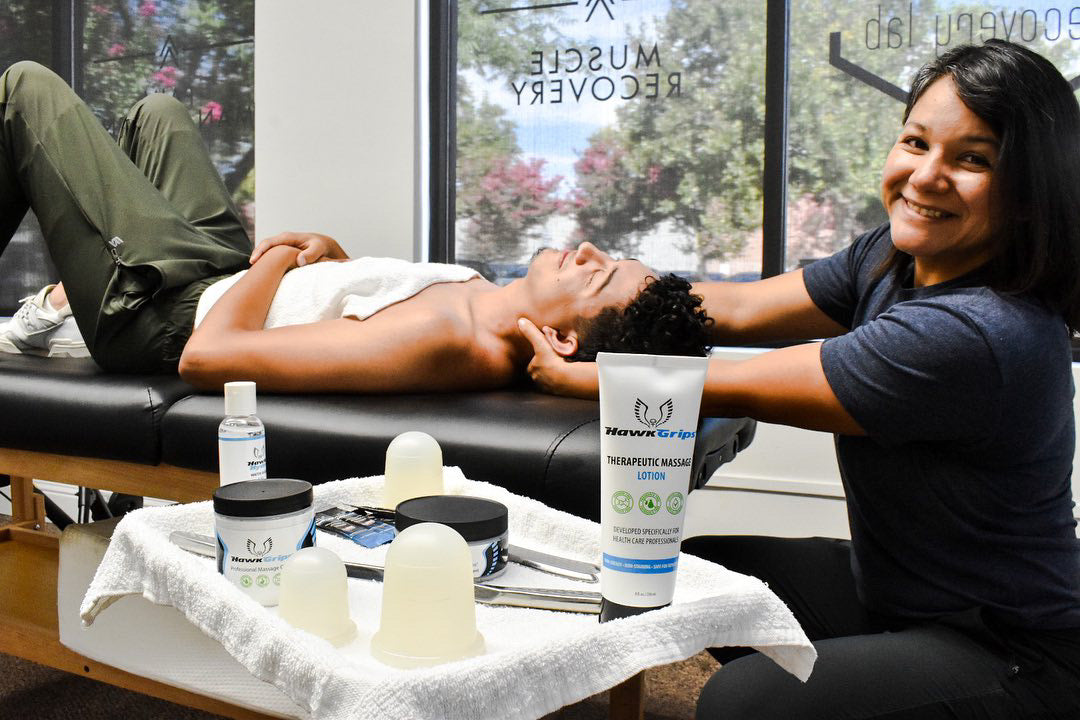The Role of Emollient Cream in Therapy
Clinicians know the right emollient cream can make or break a treatment session. Whether it’s used for IASTM, cupping, or manual therapy, emollient plays a crucial role in reducing friction, protecting the skin, and supporting patient comfort.
But not all emollients are created equal. The wrong choice can leave behind a greasy residue, trigger irritation in sensitive patients, or disrupt treatment flow.
For the best outcomes, a professional-grade emollient cream should provide the right amount of glide, be safe for sensitive skin, and clean up quickly, allowing clinicians to move smoothly between modalities. Clean, allergen-free formulas are particularly important, as even small additives can irritate sensitive patients.
What Is an Emollient Cream in Therapy?
In a clinical setting, an emollient cream is more than just a moisturizer. It acts as a treatment medium that reduces friction, allows instruments or hands to glide smoothly, and minimizes irritation on the patient’s skin. This makes it essential for therapies like IASTM, cupping, soft tissue mobilization, and manual therapy.
Other options, like oils or lotions, often fall short here. Oils can feel too slick, making control difficult, while lotions tend to absorb too quickly, requiring constant reapplication. A professional emollient cream strikes the right balance of long-lasting glide that supports both clinician technique and patient comfort.

Why Choosing the Right Emollient Cream Matters
The emollient you choose affects both patient comfort and clinical efficiency. For patients, especially those with sensitive skin, the right emollient cream helps reduce irritation and makes treatment more comfortable.
Clinicians benefit from a product with the right texture. Smooth, consistent glide prevents instruments from dragging and reduces the need for reapplication mid-session.
Post-treatment workflow is another consideration. Some emollients leave a greasy residue that makes taping or cupping difficult. A professional emollient should wipe away nicely, allowing clinicians to move seamlessly into their next step.
Finally, versatility matters. A high-quality emollient should be safe and effective across patient populations, from athletes and post-op patients to older adults with more delicate skin.
Key Qualities of a Professional-Grade Emollient Cream
Not all emollients are created equal, and choosing the right one comes down to a few key qualities. 
A clean formula is essential. Professional-grade emollient creams should be free from dyes, fragrances, and harsh additives that can irritate sensitive skin. Allergen-conscious formulations are also important, especially for patients with unknown sensitivities.
Consistency matters just as much as ingredients. Water-based emollients wipe off easily without soap or water, while non-greasy, residue-free options allow treatments to flow without interruption.
Finally, optimal glide is crucial. The right emollient maintains texture throughout a session, neither breaking down too quickly nor absorbing too fast. This ensures instruments and hands move smoothly over the skin, improving clinician efficiency and patient comfort.
By focusing on these qualities– clean, allergen-conscious, easy-to-clean, and consistent glide– clinicians can choose an emollient cream that works reliably across treatments and patient types.
Understanding Ingredients: Why Formula Matters for Sensitive Skin
When it comes to sensitive skin, what’s in an emollient cream matters just as much as how it performs. Many products contain dyes, fragrances, parabens, or other harsh chemicals that can trigger irritation or allergic reactions, even in patients without known sensitivities.
Professional-grade HawkGrips Emollients are formulated specifically for clinical use, with no harsh additives or harmful chemicals. The carefully selected ingredients provide smooth glide while protecting the skin.
By focusing on clean, gentle formulas, clinicians can protect sensitive skin without compromising performance, supporting better outcomes and patient comfort across treatments.
How Emollient Cream Supports IASTM, Cupping, and Manual Therapy
A professional emollient cream plays a central role in therapy. For IASTM, it enhances instrument glide, reduces skin drag, and allows clinicians to perform precise, effective strokes without causing irritation. Consistent texture throughout the session helps maintain patient comfort and treatment efficiency.
In cupping therapy, emollient is key to creating the proper seal. Too little glide makes cups stick unevenly, while too much slipperiness prevents suction. A well-formulated emollient balances glide and control, making it easier to achieve the desired effect without compromising comfort.
During manual therapy, emollient reduces friction on the skin, minimizing clinician strain while protecting delicate tissue. Smooth glide allows therapists to apply consistent pressure, improving outcomes across all treatments.
Ultimately, the right emollient improves both patient experience and clinician performance, supporting more effective and comfortable sessions.
Oil-Based vs Water-Based Emollients: Choosing the Right Fit for Therapy
Clinicians select emollients based on modality, patient needs, and workflow. Having options allows therapists to match the product to each session for optimal performance and comfort.
HawkGrips Emollient (oil-based) is available in vanilla and fragrance-free options. Its richer texture provides long-lasting glide, ideal for IASTM and deep soft tissue work. Because it maintains consistency throughout a session, clinicians rarely need to reapply mid-treatment, making it a top choice for procedures requiring sustained glide.
HawkHydro Emollient (water-based gel) offers a lighter, non-greasy texture that wipes away quickly without soap or water. Its easy-clean formula is ideal for sessions where taping or cupping follows immediately after treatment. Designed with sensitive skin in mind, HawkHydro is free from common allergens while still providing smooth glide for effective therapy.
Understanding the differences between oil- and water-based emollients helps clinicians select the right product for each patient and treatment type, supporting both comfort and efficiency.
Finding the Right Emollient for Your Patients
A professional emollient cream isn’t just about glide– it’s about protecting the skin, keeping treatments efficient, and making therapy comfortable. Choosing a formula that is gentle on sensitive skin, easy to clean, and consistent in performance helps clinicians focus on technique. HawkGrips offers both oil- and water-based options designed with these needs in mind, so therapists can select the emollient best suited for each modality and patient. Integrating the right emollient supports smoother treatments, better patient experiences, and less interruption during care.

